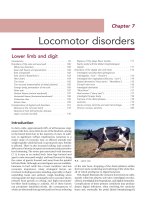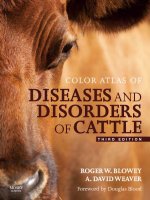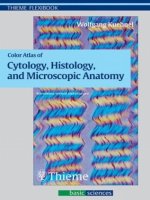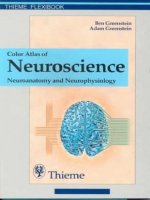color atlas of cytology, histology, and microscopic anatomy - wolfgang kuhnel
Bạn đang xem bản rút gọn của tài liệu. Xem và tải ngay bản đầy đủ của tài liệu tại đây (24.6 MB, 543 trang )
At a Glance
Cells 2
Epithelial Tissue 76
Exocrine Glandular Epithelium 90
Connective and Supportive Tissue 100
Muscular Tissue 158
Nerve Tissue 180
Blood Vessels, Blood and Immune System 200
Endocrine Glands 254
Digestive System 272
Respiratory System 340
Urinary Organs 352
Male Sexual Organs 376
Female Sexual Organs 400
Integumentary System, Skin 438
Somatosensory Receptors 450
Sensory Organs 458
Central Nervous System 490
Tables 502
Index 519
Kuehnel, Color Atlas of Cytology, Histology, and Microscopic Anatomy © 2003 Thieme
All rights reserved. Usage subject to terms and conditions of license.
Kuehnel, Color Atlas of Cytology, Histology, and Microscopic Anatomy © 2003 Thieme
All rights reserved. Usage subject to terms and conditions of license.
Color Atlas of
Cytology,
Histology, and
Microscopic
Anatomy
4th edition, revised and
enlarged
Wolfgang Kuehnel, M.D.
Professor
Institute of Anatomy
Universität zu Luebeck
Luebeck, Germany
745 illustrations
Thieme
Stuttgart · New York
Kuehnel, Color Atlas of Cytology, Histology, and Microscopic Anatomy © 2003 Thieme
All rights reserved. Usage subject to terms and conditions of license.
Library of Congress Cataloging-in-Publication
Data is available from the publisher.
1st English edition 1965
2nd English edition 1981
3rd English edition 1992
1st German edition 1950
2nd German edition 1965
3rd German edition 1972
4th German edition 1978
5th German edition 1981
6th German edition 1985
7th German edition 1989
8th German edition 1992
9th German edition 1995
10th German edition 1999
11th German edition 2002
1st Italian edition 1965
2nd Italian edition 1972
3rd Italian edition 1983
1st Spanish edition 1965
2nd Spanish edition 1975
3rd Spanish edition 1982
4th Spanish edition 1989
5th Spanish edition 1997
1st Japanese edition 1973
2nd Japanese edition 1982
1st Greek edition 1986
1st French edition 1991
2nd French edition 1997
1st Portuguese edition 1991
1st Hungarian edition 1997
This book is an authorized translation of the
11th German edition published and copy-
righted 2002 by Georg Thieme Verlag, Stutt-
gart, Germany. Title of the German edition: Ta-
schenatlas der Zytologie, Histologie und mi-
kroskopischen Anatomie.
Translated by Ursula Peter-Czichi, PhD, Atlanta,
GA, U SA.
© 1965, 2003 Georg Thieme Verlag,
Rüdigerstraße 14, D-70469 Stuttgart, Germany
Thieme New York, 333 Seventh Avenue,
New York, N.Y. 10001, U.S.A.
Cover design: Cyclus, Stuttgart
Typesetting by Gulde, Tübingen
Printed in Germany by Appl, Wemding
ISBN 3-13-562404-8 (GTV)
ISBN 1-58890-175-0 (TNY) 12345
Important Note: Medicine is an ever-changing
science undergoing continual development. Re-
search and clinical experience are continually
expanding our knowledge, in particular our
knowledge of proper treatment and drug ther-
apy. Insofar as this book mentions any dosage or
application, readers may rest assured that the
authors, editors, and publishers have made
every effort to ensure that such references are in
accordance with the state of knowledge at the
time of production of the book.
Nevertheless, this does not involve, imply, or ex-
press any guarantee or responsibility on the part
of the publishers in respect of any dosage in-
structions and formsof applications stated in the
book. Every user is requested to examine care-
fully the manufacturers’ leaflets accompanying
each drug and to check, if necessary in consulta-
tion with a physician or specialist, wether the
dosage schedules mentioned therein or the con-
traindications stated by the manufacturers differ
from the statements made in the present book.
Such examination is particularly important with
drugs that are either rarely used or have been
newly released on the market. Every dosage
schedule or every form of application used is en-
tirely at the user’s own risk and responsibility.
The authors and publishers request every user to
report to the publishers any discrepancies or in-
accuracies noticed.
Some of the product names, patents, and regis-
tered designs referred to in this book are in fact
registered trademarks or proprietary names
even though specific reference to this fact is not
always made in the text. Therefore, the appear-
ance of a name without designation as proprie-
tary is not to be construed as a representation by
the publisher that it is in the public domain.
This book, including all parts thereof, is legally
protected by copyright. Any use, exploitation, or
commercialization outside the narrow limits set
by copyright legislation, without the publisher’s
consent, is illegal and liable to prosecution. This
applies in particular to photostat reproduction,
copying, mimeographing or duplication of any
kind, translating, preparation of microfilms, and
electronic data processing and storage.
Kuehnel, Color Atlas of Cytology, Histology, and Microscopic Anatomy © 2003 Thieme
All rights reserved. Usage subject to terms and conditions of license.
Preface
This new English edition has been completely revised and updated. The
pocket atlas is meant as a companion to lectures. It also serves as a valuable
orientation tool for course work in microscopic anatomy. More than ever be-
fore, histology plays a very important role in medicine and biology. There-
fore, the short instructive texts have been updated so that they incorporate
the latest scientific findings. An understanding of micromorphological tech-
niques is a prerequisite for the study of biochemistry, physiology and the
relatively young discipline of molecular cell biology. Accordingly, cytology
and histology rank high in the curriculum.
This pocket atlas does not attempt to provide a complete theoretical knowl-
edge of histology, which may be approached using comprehensive works on
cytology, histology and microscopic anatomy. It rather conveys a basic
understanding of the elements in histology and the microscopic anatomy of
the human body. Students of histology will value this pocket atlas as a course
companion book while using microscopic techniques. The atlas will help
them to recognize the crucial elements and structures in a histological image
and make it easier to arrive at the correct diagnosis.
You will find 16 tables in the appendix. Students have suggested this addi-
tion. With the help of these tables, students can test their ability to recognize
and interpret the relevant structures in histological images.
The intuitive layout of the current edition makes it easy to find references.
Many new images have been added.
I am grateful to my colleagues of the Lübeck Institute of Anatomy for their in-
valuable assistance in creating this new edition. The names of my colleagues
who graciously provided original images are listed in the appendix.
My secretary, Mrs. Roswitha Jönsson, was an extraordinary help to me. She
took care of the final corrections to the manuscript. My thanks go to Mr. Al-
brecht Hauff and Dr. Wolfgang Knüppe who supervised this edition with
their customary care. Special thanks also go the talented team at the Georg
Thieme Verlag.
I hope that this latest edition of the pocket atlas will be a helpful guide for
students of medicine, dentistry, veterinary medicine, biology and related
sciences. I wish that it might open your window to the fascinating world of
the smallest structures of the organism.
Lübeck, Spring of 2003 Wolfgang Kühnel
Kuehnel, Color Atlas of Cytology, Histology, and Microscopic Anatomy © 2003 Thieme
All rights reserved. Usage subject to terms and conditions of license.
Kuehnel, Color Atlas of Cytology, Histology, and Microscopic Anatomy © 2003 Thieme
All rights reserved. Usage subject to terms and conditions of license.
Contents
Cells 2
Variety of Cell Forms
2
Cell Nucleus
6
Cell Division, Mitosis and Cytokinesis
10
Cytoplasmic Organelles
14
Cytoplasmic Matrix Components
38
Microvilli
52
Cell Junctions
72
Epithelium 76
Exocrine Glands 90
Connective and Supportive Tissue 100
Mesenchymal Cells and Fibroblasts
100
Collagen Fibers
114
Embryonal Connective Tissue—Mesenchyme
124
Embryonal Connective Tissue—Gelatinous or Mucous Tissue
126
Adipose Tissue
126
Loose Connective Tissue
130
Dense Connective Tissue
132
Cartilage
140
Histopenesis of Bone
146
Muscular Tissue 158
Smooth Muscle—Urinary Bladder
158
Striated (Skeletal) Muscle
162
Cardiac Muscle—Myocardium—Left Ventricle
172
Nerve Tissue 180
Multipolar Nerve Cells—Spinal Cord
180
Neuroglia—Astrocytes
186
Nerve Fibers
188
Blood Vessels, Blood and Immune System 200
Arteries, Veins and Lymphatic Vessels
200
Bone Marrow and Blood
226
Thymus
234
Lymph Nodes
238
Spleen
242
Tonsils
248
Gut-Associated Lymphoid Tissue
252
Kuehnel, Color Atlas of Cytology, Histology, and Microscopic Anatomy © 2003 Thieme
All rights reserved. Usage subject to terms and conditions of license.
Endocrine Glands 254
Hypophysis—Pituitary Gland
254
Pineal Gland—Epiphysis Cerebri
256
Adrenal Gland
258
Thyroid Gland
262
Parathyroid Gland
266
Pancreatic Islets of Langerhans
268
Digestive System 272
Oral Cavity, Lips, Tongue
272
Salivary Glands
278
Tooth Development and Teeth
284
Esophagus
292
Esophagus—Cardia—Esophagogastric Junction
294
Small Intestine
300
Large Intestine
310
Enteric Nervous System
314
Liver
318
Gallbladder
330
Pancreas
332
Greater Omentum
338
Respiratory System 340
Nose
340
Larynx
342
Trachea
344
Lung
346
Urinary Organs 352
Kidney
352
Ureter and Urinary Bladder
372
Male Reproductive Organs 376
Testis
376
Leydig Cells
384
Epididymis
388
Ductus deferens
392
Spermatic Cord, Penis
394
Seminal Vesicles and Prostate Gland
396
Female Reproductive Organs 400
Ovary—Primordial Follicle
400
Ovary—Primary Follicle—Secondary Follicle—Graafian Follicle
400
Oocyte
412
Uterus
416
Vagina
428
Placenta
430
Nonlactating Mammary Gland
434
Kuehnel, Color Atlas of Cytology, Histology, and Microscopic Anatomy © 2003 Thieme
All rights reserved. Usage subject to terms and conditions of license.
Integumentary System, Skin 438
Thick Skin
438
Thin Skin
442
Hairs and Nails
444
Eccrine Sweat Glands—Glandulae Sudoriferae Eccrinae
446
Apocrine Sweat Glands—Glandulae Sudoriferae Apocrinae—Scent Glands
448
Somatosensory Receptors 450
Sensory Organs 458
Eye
458
Ear
482
Eustachian Tube—Auditory Tube
486
Taste Buds
486
Central Nervous System 490
Spinal Cord—Spinal Medulla
490
Spinal Ganglion
492
Cerebral Cortex
494
Cerebellar Cortex
498
Tables 502
Table 1 Frequently used histological stains
502
Table 2 Surface epithelia: classification
502
Table 3 Salivary glands: attributes of serous and mucous acini in light microscopy
503
Table 4 Seromucous (mixed) salivary glands and lacrimal gland
504
Table 5 Connective tissue fibers: morphological attributes
505
Table 6 Biological “fibers”: nomenclature
506
Table 7 Exocrine glands: principles of classification
507
Table 8 Muscle tissue: distinctive morphological features
508
Table 9 Stomach: dif ferential diagnosis of the various segments of the stomach.
508
Table 10 Intestines: differential diagnosis of the segments
509
Table 11 Kidney: tubules and their light microscopic characteristics
510
Table 12 Trachea and bronchial tree: morphological characteristics
51 1
Table 13 Lymphatic organs: distinctive morphological features
512
Table 14 Hollow organs: differential diagnosis
513
Table 15 Alveolar glands and “gland-like” organs: differential diagnosis
514
Table 16 Skin areas: differential diagnosis
516
Index 519
Kuehnel, Color Atlas of Cytology, Histology, and Microscopic Anatomy © 2003 Thieme
All rights reserved. Usage subject to terms and conditions of license.
2
Cells
1 Spinal Ganglion Cells
Human and animal cells are dedicated to specialized functions within the or-
ganism, and their sizes, shapes and structures vary accordingly. Spinal gan-
glion cells are mostly pseudounipolar neurons and can be spherical, ellipsoid,
or pear-shaped, with diameters between 20 and 120μm. The round cell nu-
clei, up to 25μm in size, contain little chromatin
1
. The nuclei always have a
clearly visible nucleolus (2–4 μm). Glial cells form a layer around the spinal
ganglion cells. Therefore, they are also called satellite cells
2
. The small
round or spindle-shaped nuclei of these satellite cells stand out because they
are heavily stained. There are delicate connective tissue fibers (endoneu-
rium) and nerve fiber bundles (fascicles)
3
between the ganglion cells. In the
upper right of the figure, a wide strand of connective tissue (stained blue)
traverses the section (cf. Figs. 32, 66, 256, 671–674).
1 Nucleus with clearly visible nucleolus
2 Satellite cells
3 Nerve fibers
4 Capillaries
Stain: azan; magnification: × 400
2 Multipolar Neurons
Anterior horn motor cells—i.e., motor neurons of the columna anterior from the
spinal cord—were obtained by careful maceration of the spinal cord and
stained as a “squeeze preparation” (tissue spread out by gentle pressure).
This technique makes it possible to preserve long stretches of the numerous
long neurites and make them visible after staining. In a tissue section, most
of the cell processes would be sheared off (see Fig. 20). In this preparation, it
is hardly possible to distinguish between axons (neurites, axis cylinder) and
the heavily branched dendrites. Axons extend from the nerve cell to the mus-
culature and form synapses.
Stain: carmine red; magnification: × 80
3 Smooth Muscle Cells
The structural units of the smooth musculature are the band-shaped or
spindle-shaped muscle cells, which usually occur in bundles of different
sizes. Muscle cells build strong layers, e.g., in the walls of hollow organs (cf.
Figs. 220–223). They can be isolated from these hollow organs by maceration
with nitric acid. However, the long, extended cell processes often break off
during this procedure. Dependent on their location and function in the
tissue, smooth muscle cells are between 15 and 200 μm long. During preg-
nancy, uterine smooth muscle cells may reach a length of 1000 μm. On aver-
age, they are 5–10 μm thick. The rod-shaped nucleus is located in the cell
center. When muscle cells contract, the nucleus sometimes coils or loops
into the shape of a corkscrew.
Stain: carmine red; magnification: × 80
Kuehnel, Color Atlas of Cytology, Histology, and Microscopic Anatomy © 2003 Thieme
All rights reserved. Usage subject to terms and conditions of license.
3
1
2
4
3
1
2
3
Cells
Kuehnel, Color Atlas of Cytology, Histology, and Microscopic Anatomy © 2003 Thieme
All rights reserved. Usage subject to terms and conditions of license.
4
Cells
4 Fibrocytes—Fibroblasts
In connective tissue sections, the nonmotile (f ixed) fibrocytes look like thin,
spindle-shaped elements. However, their true shape can be brought out in
thin whole-mount preparations. Fibrocytes are sometimes rounded, some-
times elongated, flattened cells with membranous or thorn-like processes
1
.
The cell processes often touch each other and form a web. Their large, mostly
oval nuclei feature a delicate chromatin structure (not visible in this prepara-
tion). Here, the nuclei appear homogeneous (cf. Figs. 135–139).
Fibroblasts biosynthesize all components of the fibers and the extracellular
matrix (ground substances). Fibrocytes are fibroblasts that show much lower
rates of biosynthetic activity.
1 Fibrocytes with cytoplasmic processes
2 Nuclei from free connective tissue cells
Stain: Gomori silver impregnation, modified; magnification: × 650
5 Purkinje Cells—Cerebellar Cortex
Pear-shaped Purkinje cells, which are about 50–70μm high and 30–35 μm
wide (cell soma, perikaryon)
2
, send out 2–3μm thick dendrites that branch
out like trellis trees. These delicate trees reach up to the cortical surface, ex-
tending their fine branches espalier-like in only one plane. The axon (ef-
ference)
1
spans the distance between the basal axon hillock and the cerebel-
lar cortex. The elaborate branching can only be seen using metal impregna-
tion (cf. Figs. 254, 681, 682).
1Axon
2 Perikaryon
Stain: Golgi silver impregnation; magnification: × 50
6 Oocyte
Oocyte from a sea urchin ovary. Large, heavily stained nucleolus
2
inside a
loosely structured nucleus
1
. The finely granulated cytoplasm contains yolk
materials. Cell organelles are not visible (cf. Figs. 542–550, 557).
1 Nucleus
2 Nucleolus
Stain: azan; magnification: × 150
7 Vegetative Ganglion Cell
Large vegetative ganglion cell from the Auerbach plexus (plexus myentericus)
from cat duodenum. A collateral branches from the upward extending axon.
The downward-pointing cell processes are dendrites. Note the large nucleus
(cf. Figs. 432–437).
Stain: Cauna silver impregnation; magnification: × 650
Kuehnel, Color Atlas of Cytology, Histology, and Microscopic Anatomy © 2003 Thieme
All rights reserved. Usage subject to terms and conditions of license.
5
1
2
4
1
2
5
1
2
6
7
Cells
Kuehnel, Color Atlas of Cytology, Histology, and Microscopic Anatomy © 2003 Thieme
All rights reserved. Usage subject to terms and conditions of license.
6
Cells
8 Cell Nucleus
The nucleus is the center for the genetically determined information in every
eukaryotic cell. The nucleus also serves as a command or logistics center for
the regulation of cell functions. There is a correlation between the geometry
of the nucleus and the cell dimensions, which offers important diagnostic
clues. The nucleus is usually round in polygonal and isoprismatic (cuboid)
cells and ellipsoid in pseudostratified columnar cells; it has the form of a
spindle in smooth muscle cells and is flattened in flat epithelial cells. In gra-
nulocytes, the nucleus has several segments. The fibrocyte in this figure is
from subcutaneous connective tissue. Its elongated, irregularly lobe d nu-
cleus shows indentations and deep dells. The structural components of a nu-
cleus are the nuclear membrane, the nuclear lamina, the nucleoplasm, and the
chromosomes with the chromatin and the nucleolus. The chromatin is finely
granular (euchromatin), but more dense near the inner nuclear membrane
(heterochromatin). The small electron-dense patches are heterochromatin
structures as well. The DNA is packaged in a much denser form in heterochro-
matin than in euchromatin, and heterochromatin therefore appears more
heavily stained in light microscopy preparations. A nucleolus is not shown
here. The cytoplasm of the fibrocyte contains mitochondria
1
, osmiophilic
secretory granules
2
, vesicles, free ribosomes and fragments of the rough
(granular) endoplasmic reticulum membranes. Collagen fibrils are cut longi-
tudinally or across their axis
3
.
Electron microscopy; magnification: × 13 000
9 Cell Nucleus
Detail section showing two secretory cells from the mucous membranes of
the tuba uterina (oviduct). Their long, oval nuclei show multiple indentations
of different depths. Therefore, the nucleus appears to be composed of
tongues and irregular lobes in this preparation. The cytoplasm extends into
the deep nuclear indentations. The distribution of the finely granular chro-
matin (euchromatin) is relatively even. Only at the inner nuclear membrane
is the chromatin condensed in a fine osmiophilic line. The cytoplasm in the
immediate vicinity of the nucleus contains cisternae from granular endo-
plasmic reticulum
1
, secretory granules
2
and sporadically, small mitochon-
dria.
Electron microscopy; magnification: × 8500
10 Cell Nucleus
Rectangular nucleus in an orbital gland cell from the water agama (lizard).
The nucleus contains two strikingly large nucleoli
1
, which are surrounded
by a ring of electron-dense heterochromatin
. This heterochromatin con-
tains the genes for the nucleolus organizer. The heterochromatin layer along
the inner nuclear membrane or the nuclear lamina shows several gaps, thus
forming nuclear pores.
i Expanded intercellular space
→ In the lower part of the picture are two cell contacts in the form of desmosomes
Electron microscopy; magnification: × 12 000
Kuehnel, Color Atlas of Cytology, Histology, and Microscopic Anatomy © 2003 Thieme
All rights reserved. Usage subject to terms and conditions of license.
7
2
3
1
8
2
1
9
1
i
10
Cells
Kuehnel, Color Atlas of Cytology, Histology, and Microscopic Anatomy © 2003 Thieme
All rights reserved. Usage subject to terms and conditions of license.
8
Cells
11 Cell Nucleus
Round cell nucleus (detail section) to illustrate the nuclear membrane. In
light microscopy, cell nuclei are surrounded by a darkly stained line, which
represents the nuclear membrane.
This nuclear membrane consists of two cytomembranes, which separate the
karyoplasm from the hyaloplasm. Between the two membranes is the
20–50 nm wide perinuclear space, the perinuclear cisterna
1
, which com-
municates with the vesicular spaces b etween the endoplasmic reticulum
membranes. The outer nuclear membrane is confluent with the endoplasmic
reticulum and shows membrane-bound ribosomes. The perinuclear cisterna
is perforated by nuclear pores
(see Fig.12), which form pore complexes.
Their width is about 30–50 nm, and they are covered with a diaphragm. At
these covered pores, the outer and inner nuclear membrane lamellae merge.
In the adjacent cytoplasm, close to the nuclear membrane, are cisternae of
the granular endoplasmic reticulum
2
. The inner lamella of the nuclear
membrane is covered with electron-dense material. This is heterochromatin,
which is localized at the inner nuclear lamina
3
.
1 Perinuclear cisterna
2 Granular endoplasmic reticulum
3 Heterochromatin
Electron microscopy; magnification: × 50 000
12 Cell Nucleus
Tangential section through the surface of a cell nucleus. Note the pores in the
nuclear membrane
. A look in the direction of the chromatin at the inner
nuclear membrane shows a ring-shaped osmiophilic area with coarse gra-
nules. There is no heterochromatin close to the round cell pores. In the ad-
jacent cytoplasm are mitochondria
1
and rough endoplasmic reticulum
membranes
2
.
1 Mitochondria
2 Granular endoplasmic reticulum
Electron microscopy; magnification: × 38 000
13 Cell Nucleus
Cell nucleus and adjacent cytoplasm from an enterocyte (jejunum) in a
freeze-fracture plane (cryofracture, freeze-etching), which renders a profile
view of the nuclear membranes. The view is on the inner side of the inner la-
mella of the inner nuclear double membrane
1
. The white fracture line in
this figure corresponds to the perinuclear cisterna (Fig.11). The lower plane
2
gives a view of the inner side of the inner lamella of the outer nuclear
double membrane. Note the abundance of nuclear pores
3
, which allow the
intracellular transport of materials between nucleus and cytoplasm. Note
that the two nuclear membranes merge at the pore region. Above the nucleus
are vesicles of various sizes and an array of Golgi membranes
4
.
1 Inner lamella of the inner nuclear membrane
2 Inner lamella of the outer nuclear membrane
3 Nuclear pores
4 Area with Golgi membranes
Electron microscopy; magnification: × 22 100
Kuehnel, Color Atlas of Cytology, Histology, and Microscopic Anatomy © 2003 Thieme
All rights reserved. Usage subject to terms and conditions of license.
9
3
1
2
1
11
1
2
2
12
2
3
1
4
13
Cells
Kuehnel, Color Atlas of Cytology, Histology, and Microscopic Anatomy © 2003 Thieme
All rights reserved. Usage subject to terms and conditions of license.
10
Cells
14 Mitosis and Cytokinesis
The most common type of nuclear cell division is mitosis. Mitosis yields two
genetically identical daughter nuclei. It is followed by cell division (cyto-
kinesis). The inactive period between active periods of cell division is called
interphase. Nuclear division and cell division are the high points of the cell
cycle. This cycle is segmented into the phases G1, S, G2 and mitosis. Mitosis is
completed in six consecutive steps.
The figure on the right presents different stages of mitosis. The dividing cells
were Indian muntjac fibroblasts in cell culture (Muntiacus muntjac).
a) Interphase. Phase between divisions. The chromatin is dispersed or forms
small aggregates. It is often possible to distinguish between highly con-
densed chromatin, called heterochromatin, and less densely packed chro-
matin, called euchromatin. One or two nucleoli are routinely present.
b) Prophase. Begin of mitosis. The chromatin condenses to form chromoso-
mal threads, which become increasingly thicker and shorter (coil stage,
spirem). The nucleolus dissolves and the nuclear membrane falls apart.
The nuclear spindle forms and provides the apparatus for chromosome
movement. The nuclear membrane dissolves in the following prometa-
phase.
c) Metaphase. The chromosomes are arranged in the equatorial plane of the
spindle, the metaphase plane. It now becomes apparent that there are two
identical sister chromatids in each chromosome. Each chromatid has an
area for the attachment to one of the spindle fibers, which extends to both
spindle poles. This is the stage when karyotyping works best.
d-f) Anaphase. The two identical sister chromatids separate and move to the
cell pole. Phase of the double (daughter) stars or diaster. In a later ana-
phase stage, a cytokinetic actin ring forms in the position of the equatorial
plane.
g) Telophase. Completion of the nuclear division. The chromatids combine
and form a coil. A new nuclear membrane forms, the cytoplasm divides by
contracting the cytokinetic actin ring (division ring) (cytokinesis).Anew
cell wall is synthesized in the place of the cytokinetic actin ring.
h) Interphase.
Stain: DNA-specific Feulgen reaction
15 Chromosomes
Chromosomes in the metaphase of mitosis. The centromeres are stained with
the DNA fluorescence dye DAPI blue, the chromosome arms aredyedred
using the immunoassay for the protein pKi-67 in the “perichromosomal
layer.” All chromosomes consist of two chromatids, which are connected only
via centromere. The chromosome set for the mouse species CD in this figure
consists of four acrocentric chromosomes (one-armed, V-shaped in this
phase), chromosomes 19, X and Y, and 18 metacentric chromosomes (two-
armed, X-shaped in this phase), which are the result of the centric fusion of
two formerly acrocentric chromosomes.
Magnification: × 2600
Kuehnel, Color Atlas of Cytology, Histology, and Microscopic Anatomy © 2003 Thieme
All rights reserved. Usage subject to terms and conditions of license.
11
ab dc
ef gh
14
15
Cells
Kuehnel, Color Atlas of Cytology, Histology, and Microscopic Anatomy © 2003 Thieme
All rights reserved. Usage subject to terms and conditions of license.
12
Cells
16 Mitosis
During the division of the cell nucleus of eucytes (mitosis), the chromosomes
for the future daughter cells are separated (cf. Fig.14). The figure shows a
dividing fibroblast in the anaphase (ana, Greek: upward). This is the shortest
phase in the mitotic process. The two daughter chromosome sets
1
are al-
ready separated as far as possible, and the division spindle is dismantled.
There are now two chromatid stars (diasters) (cf. Fig. 14 e and f). The division
of the cell body has not yet started.
1 Daughter chromosomes
Electron microscopy; magnification × 1400
17 Apoptosis
Apoptosis is a necrotic cell process. The cell triggers the process by activating
the endogenous destruction program that leads to cell death (“suicide pro-
gram of the cell”). Apoptosis plays an important part in the development of
organs as well as the control and regulation of physiological regeneration.
During apoptosis, the deoxyribonucleic acid of the cell nucleus is destroyed.
In the process, the cell nucleus not only becomes small and condensed (nu-
clear pyknosis), but it also breaks into fragments (extra nuclei, karyorrhexis),
which will finally completely dissolve (karyolysis).
Apoptosis in the cavum epithelium of the rabbit endometrium with chro-
matin bodies
1
. Cytoplasmic processes of a macrophage envelop part of the
apoptotic cell like a horseshoe
2
. Uterine clearance
3
.
1 Chromatin bodies
2 Macrophage processes
3 Uterine clearance
Electron microscopy; magnification: × 10 500
Kuehnel, Color Atlas of Cytology, Histology, and Microscopic Anatomy © 2003 Thieme
All rights reserved. Usage subject to terms and conditions of license.
13
1
1
16
2
2
3
1
1
17
Cells
Kuehnel, Color Atlas of Cytology, Histology, and Microscopic Anatomy © 2003 Thieme
All rights reserved. Usage subject to terms and conditions of license.
14
Cells
18 Ergastoplasm
Cells that biosynthesize and export large amounts of proteins have strongly
basophilic cytoplasmic regions, which have been named ergastoplasm (from
Greek: ergasticos = industrious, working cytoplasm). In light microscopic im-
ages, this basophilic material appears in a variety of forms. The homo-
geneous or banded material (chromophilic substance) from the basal part of
highly active secretory gland cells (see Fig. 19) is very well known, and so are
the smaller or larger chromophilic bodies in the cytoplasm of nerve cells (see
Fig.20). Due to their ribosome content, these cell components have a high af-
finity for basic dyes (e.g., hematoxylin). Electron microscopy reveals an elab-
orate system of densely packed granular endoplasmic reticulum (rough ER,
rER) as the material that makes up the basophilic ergastoplasm seen in light
microscopy (see Fig. 21–25).
This figure shows acini from the exocrine pancreas. These cells show pro-
nounced basal basophilia
1
. In contrast, the supranuclear and apical cyto-
plasmic regions are only sparsely granulated.
1 Cell regions with ergastoplasm, basal basophilia
2 Lumina of the acini
3 Blood vessels
Stain: hematoxylin-eosin; magnification × 400
19 Ergastoplasm
Basophilic cytoplasm (blue) in the basal regions of gland cells (basal basophi-
lia)
1
(cf. Fig. 18). The presence of ribosomes accounts for the affinity to basic
dyes. The basophilic cytoplasm corresponds to the granular (rough) endo-
plasmic reticulum (rER) (see Figs. 21–25). The supranuclear and apical cell
regions contain no ergastoplasm and therefore remain unstained. The round
cell nuclei in the basal cytoplasmic region are stained light blue. Parotid
gland (glandula parotidea) of the rat.
1 Cell regions with ergastoplasm, basal basophilia
2 Acini
3 Blood vessels
Stain: methylene blue, pH 3.5; nuclei are not specifically stained; magnification: × 400
20 Ergastoplasm—Nissl Bodies
The cytoplasm of multipolar neurons from the columna anterior of the spinal
cord contains a dense distribution of fine or coarse bodies, which can be em-
phasized by staining with cresyl violet. They are called Nissl bodies or Nissl
substance
1
(tigroid bodies), after Franz Nissl (1860–1919), who discovered
them. Electron microscopy identifies groups of polysomes and components
of the rough (granular) endoplasmic reticulum (ergastoplasm ) as the struc-
tures that correspond to the Nissl bodies (cf. Figs. 21–25, 250, 251).
1 Nissl bodies (substance)
2 Nucleus with nucleoli
3 Dendrites
4 Glial cell nuclei
Stain: cresyl violet; magnification: × 800
Kuehnel, Color Atlas of Cytology, Histology, and Microscopic Anatomy © 2003 Thieme
All rights reserved. Usage subject to terms and conditions of license.
15
1
2
3
2
18
3
1
1
2
2
19
4
2
1
3
3
20
Cells
Kuehnel, Color Atlas of Cytology, Histology, and Microscopic Anatomy © 2003 Thieme
All rights reserved. Usage subject to terms and conditions of license.
16
Cells
21 Granular (Rough) Endoplasmic Reticulum
(rER)—Ergastoplasm
The endoplasmic reticulum (ER) is a continuous system of cell membranes,
which are about 6nm thick. Dependent on cell specialization and activity,
the membranes occur in different forms, such as stacks or tubules. The ER
double membranes may be smooth or have granules attached to their outer
surfaces. These granules are about 25nm in diameter and have been identi-
fied as membrane-bound ribosomes. Therefore, two types of ER exist: the gra-
nular or rough form ( rER, rough ER) and the agranular or smooth form (sER,
smooth ER).
Paired multiplanar stacks of lamellae are one characteristic forms of rER. The
membranes are narrowly spaced and spread over large parts of the cell. The
two associated membranes in this matrix are 40–70nm apart. When cells as-
sume a storage function, these membranes move away from each other and
thus form cisternae, with a lumen that may be several hundred nanometers
wide.
Elaborate systems of rER membranes are found predominantly in cells that
biosynthesize proteins (see Figs. 19, 22–25). Proteins, which are synthesized
on membranes of the rER, are mostly exported from the cell. They may be se-
creted from the cell (including hormones and digestive enzymes, etc.) or
become part of intracellular vesicles (membrane proteins). The smooth endo-
plasmic reticulum (see Figs. 26–29) eluded light microscopy.
The cisternae of the endoplasmic reticulum interconnect both with the
perinuclear cisternae (see Fig.11) and the extracellular space.
This picture shows ergastoplasm (rER) from an exocrine pancreas cell, which
produces digestive enzymes.
Electron microscopy; magnification: × 60 000
Kuehnel, Color Atlas of Cytology, Histology, and Microscopic Anatomy © 2003 Thieme
All rights reserved. Usage subject to terms and conditions of license.









